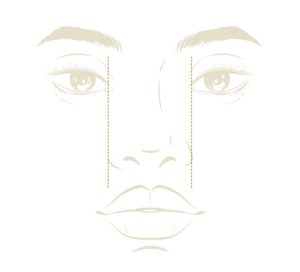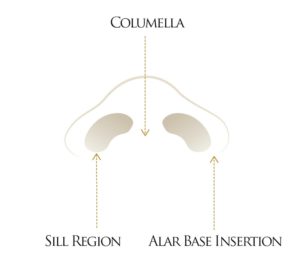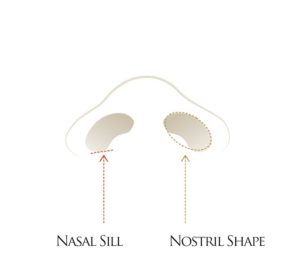Nasal base reduction, or alarplasty, refers to a rhinoplasty technique that is intended to narrow the alar base, or base, of the nose (fig. 1), in cases where it is excessively wide for the face. The alar base plays a central role in the overall proportion and appearance of the nose and the nose’s harmony with the rest of the face. An overly flared or wide alar base can lead to a nose that looks bottom heavy.1 Most rhinoplasty and revision rhinoplasty patients who are looking for nasal base reduction surgery voice a concern with a nose that looks too big or too wide at the bottom.
The width of the nasal base can be measured from the outer margin of one nostril to the outer margin of the opposite nostril and its axis can be classified as vertical, divergent, or convergent (fig. 2). Generally, the nasal base should fall between the distance between the inner corners of a patient’s two eyes (fig. 3). In other words, if you extend a vertical line towards the fine from the inner canthus (corner of the eye) on each eye, the nasal base should not exceed those two lines.
Nasal base reduction is a common procedure in rhinoplasty and revision rhinoplasty, and is frequently requested from patients desiring surgery on African American, Middle Eastern, and Asian noses, often referred to as ethnic rhinoplasty. These patient populations in particular tend to exhibit a slightly wider alar base indicating nasal base reduction to refine the nose and achieve the desired outcome. It should be noted that the “ideal” measurements above represent the caucasian aesthetic for ideal nose proportions, but not always the desired goal in ethnic rhinoplasty. In fact, for many patients seeking ethnic rhinoplasty, a more natural looking nasal base with a width that falls slightly outside the lines of the inner canthus is preferrable.
Benefits of Nasal Base Reduction Surgery
- Refines and improves the overall appearance of the nose
- Improves facial symmetry and balance
- Improves self-confidence Decreases the size of the nostrils
- Reduces nostril flare Long-lasting results
Anatomy Involved In Nasal Base Reduction
Knowledge of the nasal base anatomy (fig. 4) is essential to determining the optimal surgical technique in certain nasal base reduction rhinoplasty patients. The nostrils are separated into right and left sides by the columella, the vertical “column-like” structure that runs down the center of the nose. The nasal sill extends from either side of the bottom of the columella and extends to the alar base insertion, or the segment of the nostril side wall where it meets the cheek-upper lip junction.
In evaluating the shape of the nostrils from the base, it is clear that the anterior nasal spine, lower lateral cartilages, caudal septum, maxilla, upper lip, and the soft tissue and skin that envelope the nose are all contributing factors in the overall appearance of the nasal base and its width. Altering any one of these structural elements of the nose or their relationship to one another can change the appearance and attractiveness of the nostril shape, and affect nasal function. It is with this in mind that Dr. Cangello evaluates each patient’s unique nasal anatomy so that he can determine the surgical technique that will best achieve an improvement in the appearance of the nose and enhance functionality while still retaining the individual, racial, and ethnic characteristics unique to that patient.
Nasal Base Reduction Surgery
Alar Wedge Excision
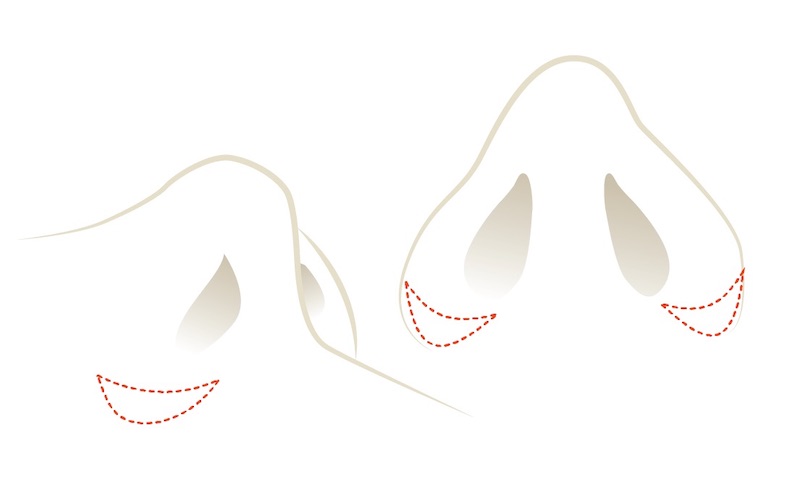
Figure 6. Alar Wedge Incision
Nasal Sill Excision
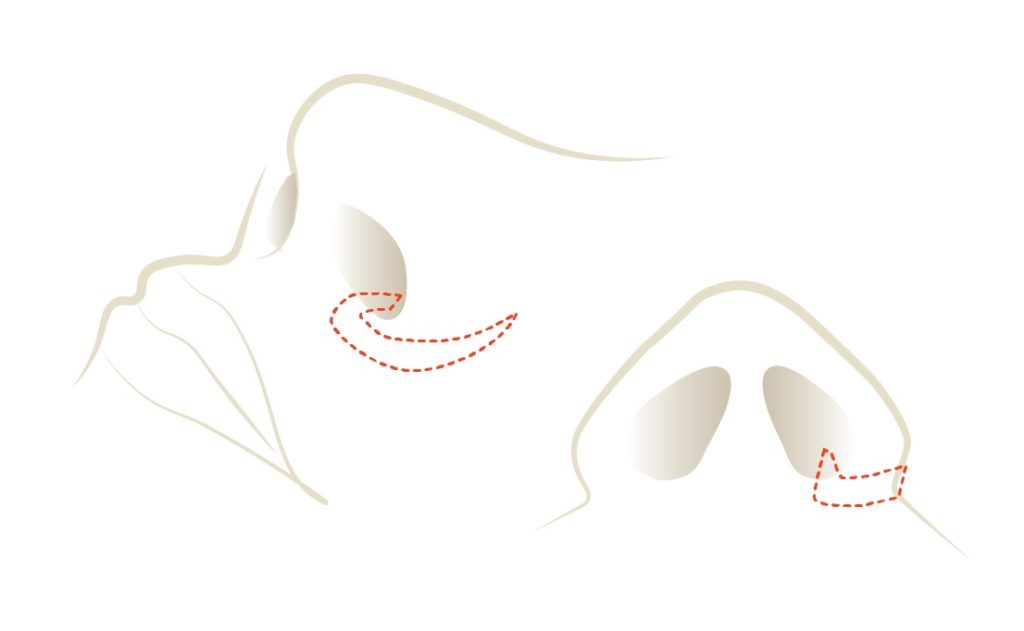
Figure 7. Nasal Sill Incision
V-Y Advancement

Figure 8. V-Y Advancement Incision
Candidates For Nasal Base Reduction Surgery
Candidates for nasal base reduction are individuals who have concerns with the excessive width of the base of their nose.
Nasal Base Reduction Risks & Recovery
Nasal base reduction is a fairly common procedure with minimal risks when working with an experienced surgeon. If performed alone (without concomitant rhinoplasty) it can be performed under local anesthesia only. Recovery time for nasal base reduction is roughly one to two weeks. Patients can expect that the base of their nose will be slightly swollen and red immediately following surgery, but this will subside gradually over the recovery period. Any stitches are typically removed one week after surgery. Full recovery takes approximately one month.
Although patients will have sutures that they may not want to show in public, patients are able to go back to work immediately following surgery if they desire. They should be careful not to rub or bump the nose for one month following surgery. Although rare, risks can include infection, bleeding, and scarring.6
Nasal Base Reduction in NYC with Dr. Cangello
Dr. Cangello is NYC’s preeminent rhinoplasty surgeon, offering patients customized treatment plans and transformative results. With a renowned ability to create noses that are both functionally superior and cosmetically beautiful, Dr. Cangello has spent decades honing his expansive skill in this nuanced medical field. Contact us today to learn more about Nasal Base Reduction or to schedule a consultation.
1 Archives of Facial Plastic Surgery. The long-term effects of alar base reduction. Available at: https://pubmed.ncbi.nlm.nih.gov/15781718/. Accessed January 29, 2021.
2 SAGE Publishing. Excessive Alar Base Resection in Rhinoplasty: How to Deal With It Once Recognized Intraoperatively? Available at: https://journals.sagepub.com/doi/pdf/10.1177/2513826X17716453. Accessed January 29, 2021.
3 Archives of Facial Plastic Surgery. A Simplified Approach to Alar Base Reduction. Available at: https://jamanetwork.com/article.aspx?articleid=480370. Accessed January 27, 2021.
4 Archives of Facial Plastic Surgery. A Simplified Approach to Alar Base Reduction. Available at: https://jamanetwork.com/article.aspx?articleid=480370. Accessed January 27, 2021.
5 Archives of Facial Plastic Surgery. A Simplified Approach to Alar Base Reduction. Available at: https://jamanetwork.com/article.aspx?articleid=480370. Accessed January 27, 2021.
6 Plastic and Reconstructive Surgery. Systematic Surgical Approach to Alar Base Surgery in Rhinoplasty. Available at: https://pubmed.ncbi.nlm.nih.gov/33234955/. Accessed January 29, 2021.



